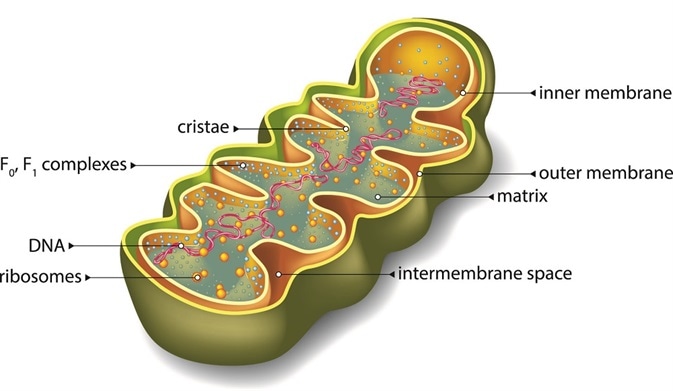By Megan Knight, BSc
Mitochondria are double membrane bound cytoplasmic organelles present in most eukaryotic cells. They are responsible for aerobic respiration, producing energy for the cell, which they achieve through oxidative phosphorylation.
 Credit: Wire_man/Shutterstock.com
Credit: Wire_man/Shutterstock.com
Cellular respiration is the metabolic process in which oxygen is used to breakdown carbohydrates, fats and proteins to generate adenosine triphosphate (ATP). Mitochondria are the ‘engine room’ of eukaryotic organisms, as they are the main site of cellular respiration.
The evolutionary origins of mitochondria
The widely accepted endosymbiont theory states that mitochondria were once an independent prokaryotic species that existed around 2 billion years ago. Unlike most other forms of early life, which used fermentation to produce energy, this prokaryote could convert oxygen into forms of energy for survival.
It is thought that this oxygen-using prokaryotic cell was engulfed by a larger primitive eukaryotic cell, following which a symbiotic relationship was established. The host cell was now able to utilise rising oxygen levels in the atmosphere as a source of energy, whereas the prokaryote was protected from predation.
Eventually, the organisms merged into one, forming a eukaryotic cell with a mitochondrion. Evidence supporting this includes the independent reproduction of mitochondria in cells by binary fission, and the presence of mitochondrial DNA.
Mitochondria possess a small amount of circular DNA, known as mtDNA; mtDNA contains 16500 base pairs encoding 37 genes, all of which are essential for mitochondrial function. These include enzymes needed for oxidative phosphorylation, and ribosomal RNA and transfer RNA needed for protein assembly.
mtDNA is only inherited from the mother, unlike nuclear DNA which is inherited from both parents. Both sperm and egg gametes contain mitochondria, however mitochondria in the sperm are broken down after fertilisation of the egg.
The structure of a mitochondrion
Mitochondria are between 1-10μm in length, and often form branched networks within cells. The outer phospholipid membrane is smooth, making the mitochondrion ‘bean-shaped’. Porin proteins embedded into the outer membrane make it permeable to fuels for aerobic respiration.
The inner phospholipid membrane has infoldings called ‘cristae’ and is less permeable. Cristae vastly increase the surface area of which cellular respiration can occur in the mitochondrion, making it much more efficient.
Cristae also divide a mitochondrion into two internal compartments. The first compartment is the ‘intermembrane space’, which is a narrow region between the inner and outer mitochondrial membranes. The second compartment is called the ‘mitochondrial matrix’; this is completely enclosed by the inner membrane. The mitochondrial matrix contains enzymes needed for cellular respiration, some of which are built into the inner membrane, mtDNA and ribosomes.
 Credit: NoPainNoGain/Shutterstock.com
Credit: NoPainNoGain/Shutterstock.com
The cellular functions of mitochondria
The main function of mitochondria is to produce energy through aerobic respiration. Principal fuels for ATP generation are fatty acids and glucose. The number of mitochondria a cell possesses depends on its metabolic demands. Eukaryotic cells with a less active metabolism may have one single large mitochondrion, whereas cells which migrate or contract, such as muscle cells, or those with an active metabolism, such as liver cells, can possess hundreds or thousands of mitochondria.
The initial stages of glucose metabolism, termed glycolysis, occur in the cytosol. Enzymes within the mitochondrial matrix and inner membrane then couple oxidation of glycolysis products and ATP synthesis in a cyclic manner known as the Krebs cycle.
Some energy produced by this cycle is then conserved within the inner membrane by the electron transport chain, which relies on the molecules NAD and FAD. The electron transport chain consists of four protein complexes, and a fifth complex which rotates in the inner membrane to generate ATP. This chain is very efficient at ATP production.
Mitochondria also have other roles within cell homeostasis, which are the conditions at which optimum function of a cell is achieved. Mitochondria are intracellular stores of calcium, which is an important signalling molecule. Calcium signalling is very dynamic and must be tightly regulated; a release of calcium ions into the cytoplasm couples to many downstream effects in cells, such as cell division. Too much cytosolic calcium results in apoptosis, which is programmed cell death.
How Mitochondria Produce Energy
The role of mitochondria in human disease
Mutations within mtDNA results in a diverse group of diseases, characterised by a failure of energy production. They result in a loss of cellular homeostasis, meaning some functions in the body fail. Well known diseases associated to mitochondrial dysfunction include:
- Parkinson’s and Alzheimer’s
- Autism
- Muscular dystrophy
Common symptoms of these diseases include: developmental delays, learning disabilities, muscle weakness, neurological problems, and heart problems.
mtDNA mutations result in such a diverse range of diseases and symptoms due to the varying metabolic demands of organs within the body. For example, the brain, liver and muscle normally consume large amounts of energy, so they are severely affected when mitochondria are dysfunctional. The severity of a mitochondrial disease also depends on the number of mitochondria carrying the mutation in the mtDNA.
Sources:
- http://www.newcastle-mitochondria.com/
- bscb.org/.../
- https://ghr.nlm.nih.gov/mitochondrial-dna
- http://mitochondrialdiseases.org/mitochondrial-disease/
- Campbell, N. A., Reece, J. B., Urry, L.A., Cain, M. L., Wasserman, S. A., Minorsky, P. V., Jackson, R. B. (2015). Biology: A Global Approach (Tenth Edition). Essex: Pearson Education Limited.
- Lodish, H., Berk, A., Kaiser, C. A., Krieger, M., Scott, M. P., Bretscher, A., Ploegh, H., Matsudaira, P. (2008). Molecule Cell Biology (Sixth Edition). New York: W. H. Freeman and Company.
Further Reading